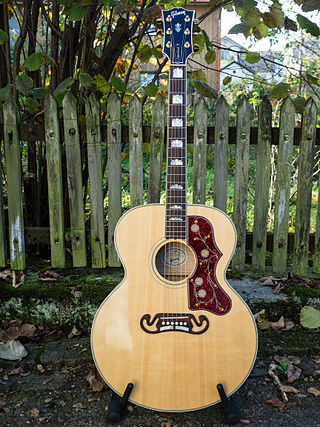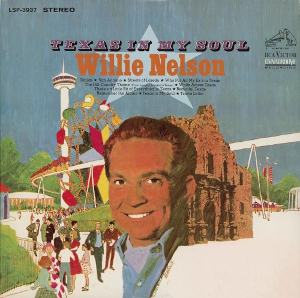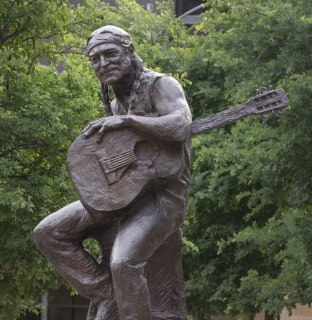
The steel-string acoustic guitar is a modern form of guitar that descends from the gut-strung Romantic guitar, but is strung with steel strings for a brighter, louder sound. Like the modern classical guitar, it is often referred to simply as an acoustic guitar, or sometimes as a folk guitar.

The guitar is a stringed musical instrument, that is usually fretted and typically has six or twelve strings. It is usually held flat against the player's body and played by strumming or plucking the strings with the dominant hand, while simultaneously pressing selected strings against frets with the fingers of the opposite hand. A plectrum or individual finger picks may also be used to strike the strings. The sound of the guitar is projected either acoustically, by means of a resonant chamber on the instrument, or amplified by an electronic pickup and an amplifier.

Willie Hugh Nelson is an American country singer, guitarist and songwriter. He was one of the main figures of the outlaw country subgenre that developed in the late 1960s as a reaction to the conservative restrictions of the Nashville sound. The critical success of his album Shotgun Willie (1973), combined with the critical and commercial success of Red Headed Stranger (1975) and Stardust (1978), made Nelson one of the most recognized artists in country music. Nelson has acted in over 30 films, co-authored several books, and has been involved in activism for the use of biofuels and the legalization of marijuana.

Red Headed Stranger is the eighteenth studio album by American outlaw country singer Willie Nelson, released in 1975. Following the success of his recordings with Atlantic Records, coupled with the negotiating skills of his manager, Neil Reshen, Nelson signed a contract with Columbia Records, the label that gave him total creative control over his works. The concept for the album was inspired by the "Tale of the Red Headed Stranger", a song that Nelson used to play as a disc jockey on his program in Fort Worth, Texas. After signing with Columbia, he decided to record the song, and arranged the details during his return to Austin, Texas, from a trip to Colorado. It was recorded at low cost at Autumn Sound Studios in Garland, Texas. The songs featured sparse arrangements, largely limited to Nelson's guitar, piano, and drums. Nelson presented the finished material to Columbia executives, who were dubious about releasing an album that they at first thought was a demo. However, Nelson had creative control, so no further production was added.

Stardust is the 22nd studio album by Willie Nelson, released in April 1978. Its ten songs consist entirely of pop standards that Nelson picked from among his favorites. Nelson asked Booker T. Jones, who was his neighbor in Malibu at the time, to arrange a version of "Moonlight in Vermont". Impressed with Jones's work, Nelson asked him to produce the entire album. Nelson's decision to record such well-known tracks was controversial among Columbia executives because he had distinguished himself in the outlaw country genre. Recording of the album took only ten days.

A pickguard is a piece of plastic or other material that is placed on the body of a guitar, mandolin or similar plucked string instrument. The main purpose of the pickguard is to protect the guitar's finish from being scratched by the nails of the picking hand, as it was included on guitars not played with a plectrum. The pick does not normally contact that part of the guitar when used correctly.

Shotgun Willie is the 16th studio album by American country music singer-songwriter Willie Nelson, released on June 11, 1973. The recording marks a change of style for Nelson, who later stated that the album "cleared his throat". When Nelson refused to sign an early extension of his contract with RCA Records in 1972, the label decided not to release any further recordings. Nelson hired Neil Reshen as his manager, and while Reshen negotiated with RCA, Nelson moved to Austin, Texas, where the ongoing hippie music scene at the Armadillo World Headquarters renewed his musical style. In Nashville, Nelson met producer Jerry Wexler, vice president of Atlantic Records, who was interested in his music. Reshen solved the problems with RCA and signed Nelson with Atlantic as their first country music artist.
An acoustic guitar is a musical instrument in the string family. When a string is plucked, its vibration is transmitted from the bridge, resonating throughout the top of the guitar. It is also transmitted to the side and back of the instrument, resonating through the air in the body, and producing sound from the sound hole. While the original, general term for this stringed instrument is guitar, the retronym 'acoustic guitar' – often used incorrectly to indicate the steel stringed model – distinguishes it from an electric guitar, which relies on electronic amplification. Typically, a guitar's body is a sound box, of which the top side serves as a sound board that enhances the vibration sounds of the strings. In standard tuning the guitar's six strings are tuned (low to high) E2 A2 D3 G3 B3 E4.

Stella was an American guitar brand owned by the Oscar Schmidt Company. It was founded around 1899. The Stella brand consists of low and mid-level stringed instruments.
Classical electric guitars, also known as nylon-string electric guitars, represent a unique fusion of traditional classical guitar design and modern electric guitar technology. These instruments combine the rich and warm tonal qualities of nylon-stringed classical guitars with the versatility and amplified sound capabilities of electric guitars. By integrating nylon strings with onboard electronics, pickups, and preamp systems, classical electric guitars offer musicians a wide range of sonic possibilities for various musical genres and performance settings.

My Own Peculiar Way is the ninth studio album by country singer Willie Nelson. It was his last release in the 1960s. Bergen White was the conductor and arranger. This became Willie's first studio album in which he used his new classical acoustic guitar called Martin N-20 that he named "Trigger".

Texas in My Soul is the seventh studio album by country singer Willie Nelson. It was an early concept album that aimed to pay tribute to the State of Texas. The original album artwork features the Alamo, along with three San Antonio construction projects completed in 1968: the Tower of the Americas, HemisFair Arena and the HemisFair monorail system.

Six Hours at Pedernales is a studio album by the country singer Willie Nelson and Step One Records co-founder Curtis Potter.

Lichty Guitars is an American company based in Tryon, North Carolina, that has been making custom acoustic guitars and ukuleles since 2009. It was founded by musician Jay Lichty.

The Family is the lead singer Willie Nelson's touring and recording group. Nelson, who did not manage through the 1960s to succeed as a singer, retired after the failure of his 1971 album Yesterday's Wine. The following year, he returned from retirement rejuvenated by the burgeoning music movement of Austin, Texas.

"Mr. Record Man" is a song written by country music singer-songwriter Willie Nelson. After writing the song, Nelson moved to Houston, Texas, where due to his financial issues, tried to sell it to Larry Butler. Butler, who rejected to buy the song, employed Nelson instead. After his original songs turned into hits for other artists, Nelson was signed as a recording artist by Liberty Records.
"Man With the Blues" is a song by country music singer-songwriter Willie Nelson. After moving to Fort Worth, Texas, and quitting the music business for a year, Nelson returned to perform on the KCUL's Country Hoedown. Through a booking agent, he was signed as a recording artist by D Records.

"The Part Where I Cry" is a song written by country music singer Willie Nelson. After moving to Nashville in 1960, leveraged by the success of his songwriting, and helped by Harlan Howard, Nelson was signed by Joe Allison of Liberty Records.

"Wake Me When It's Over" is a song written and recorded by American country music singer Willie Nelson. After being signed as a recording artist to Liberty Records in 1961, the song was recorded during his second session with the label in September 1961 at Radio Recorders. Selected as the A-side of one of the promotional singles, the song failed to chart.

The Willie Nelson statue, or simply Willie, is a bronze sculpture of singer-songwriter Willie Nelson, located in Downtown Austin, Texas. The statue was commissioned to artist Clete Shields by the nonprofit organization Capital Area Statues.


















